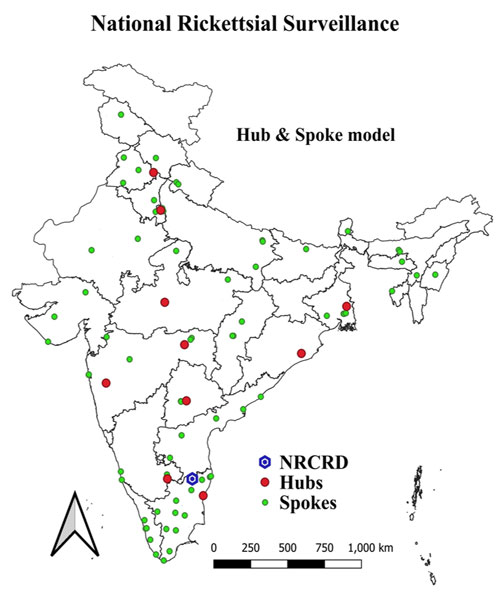
The CAR envisages development of a network of centres using the Hub and Spoke model which will generate robust data to
Plan and initiate rickettsial surveillance among cases of acute undifferentiated febrile illness (AUFI) with an aim to estimate rickettsial infection burden
Prediction models for scrub typhus and spotted fever will be eventually developed using the data generated from the rickettsial surveillance with the help of the Artificial Intelligence (AI)
Identify hot-spots of Rickettsial diseases
Devise health education modules for prevention and control
Rickettsial Surveillance:
The Hub and Spoke model established for the training and EQAS will be used for laboratory diagnosis of rickettsial infections in individuals with AUFI. The CAR along with the hubs and spokes will collect 4 ml of whole blood and 4 ml of serum from all the AUFI patients reporting to the emergency departments after informed consent. IgM ELISA for scrub typhus and spotted fever will be done using the serum samples and the results will be notified to the CAR. DNA extraction will be done from the whole blood samples as previously described and the extracted DNA will be subjected to PCR for scrub typhus and spotted fever. The data on the samples collected and the results will be entered in the mobile app which will be integrated into the website created for this project. This will ensure the real-time data monitoring system and visualize the performance of the hubs in rickettsial surveillance. This surveillance will generate the robust data for the estimation of rickettsial infection. Further, the hot-spots of these rickettsial infections of the hubs will be identified using the surveillance data generated in real-time. The information on the hotspots will be shared on a regular basis to the local/regional authorities for appropriate measures.
Prediction models for scrub typhus and spotted fever will be computed with the 5-year AUFI surveillance data from all the hubs and spokes using Artificial Intelligence (AI).
Website & mobile application:
Individual login credentials will be provided to each hub and spoke for training, EQAS and data entry. The training materials, SOPs, training videos will be uploaded and made available for all the hubs and spokes. The data on rickettsial surveillance will be entered at each centre through the mobile application in real-time. These data will be stored in the server placed at the CAR. Data cleaning and analysis will be performed every six months and the same will be shared with the hubs and spokes and to ICMR. All data corresponding to each centre will be uploaded in this website.
